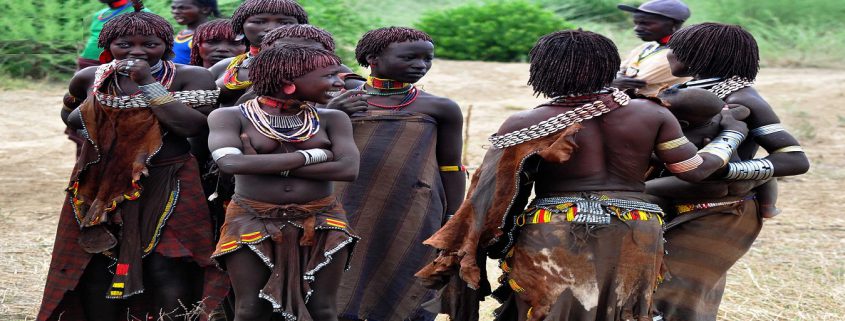Hamer
Cultural tours of Ethiopia enable onto understand the harmonious
diversity of the nation. There are 83 languages and 200 dialects spoken
throughout Ethiopia. The culture in Ethiopia is truly exotic, untouched
and authentic. Far from the modern life, the people in far field are
with natural and rustic life style that feels our origin.
Ethiopia is a mosaic of cultures for cultural tourists. The Lower Omo
Valley in the South of Ethiopia is perhaps one of the most
ethnographically diverse regions in the world. It served as an ancient
meeting point as tribes migrated from all corners of Africa and now
plays host to many different tribes each with unique and fascinating
customs. If you can handle the challenges of travelling in this remote
region, then the rewards are immense. Whether you are watching the
traditional ceremony of Hamer people jumping the Bulls or gazing
incredulously at the site of a Mursi’s lip plates, this is a place
unlike anywhere else on Earth.
The landscape and wildlife of the Lower Omo Valley is an attraction
in itself, terraced richly vegetated areas contrast with open savannah
and despite widespread poaching, hippo (Lake Chomo) and dik dik, kudu,
guinea fowl, gerenuk and various birds are frequently seen. The real
reason for the journey though is in the contrast of cultures and
learning about the traditional customs of peoples far removed from your
own lifestyle.
Hamer:- The Hamer who number around 50,000, are subsistence
agro-pastoralists. They cultivate sorghum, vegetables, millet, tobacco
and cotton, as well as rearing cattle and goats. Wild honey is an
important part of their diet.–The people are known particularly for
their remarkable hairstyles. The women mix together ochre, water and a
binding resin, rub the mixture into their hair, then twist strands again
and again to create coppery-colored tresses known as goscha. These are a
sign of health and welfare.–If they have recently killed an enemy or a
dangerous animal, the men are permitted to don clay hair buns that
sometimes support magnificent ostrich feathers. The buns — with the help
of special headdress (borkotos) for sleeping — last from three to six
months, and can be ‘redone’ for up to one year.The Hamer are also
considered masters of body decoration. Every adornment has an important
symbolic significance; earrings for example, denote the number of wives a
man has.
The women wear bead necklaces, iron coils around their arms, and
decorate their skin with cowry shells. The iron torques around their
necks are known as ensente and are worn by married or engaged women
only. They indicate the wealth and prestige of the woman’s husband.
Young, unmarried girls wear a metal plate in their hair that looks a bit
like a platypus’ bill.–The iron bracelets and armlets are an indication
of the wealth and social standing of the young girl’s family. When she
gets married, she must remove the jewellery; it is the first gift she
makes to her new family.–The Hamer territory stretches across the plains
of the Lower Omo to Chew Bahir in the east, almost to the Kenyan border
in the south, and to the territory of the Benna in the north.
The Karo:- The Karo people thought to be one of the most endangered
groups the Omo, with a population of about 1500 people. They inhabit the
eastern bank of the Omo. They were formerly pastoralists, but many of
their cattle have been wiped out by disease, and many have turned to
agriculture.In appearance, language and tradition, they slightly
resemble the Hamer, to whom they are related. The Karo are considered
masters of body painting, in which they engage when preparing for a
dance, feast or celebration. Most famously, chalk is used to imitate the
spotted plumage of the guinea fowl.The Karo are also great improvisers:
Bic biros, nails, sweets wrappers and cartridges are all incorporated
into jewellery and decoration. Yellow mineral rock, black charcoal and
pulverized red iron ore are traditionally used.
The Mursi :Perhaps the best known of the Omo peoples are the Mursi,
thought to number around 6500, are mainly pastoralists who move
according to the seasons between the lower Tama Steppe and the Mursi
Hills in Mago National Park.––Some Mursi practice flood retreat
cultivation, particularly in the areas where the tse tse fly prohibits
cattle rearing. Honey is collected from beehives made with bark and
dung. The Mursi language is Nilo-Saharan in origin.–The most famous
Mursi traditions include the fierce stick fighting between the men, and
the lip plate worn by the women which is made of clay and often quite
large, the plates are inserted into slits in their lower lips.
Anthropologists offer several theories to explain the practice: to deter
slavers looking for unblemished girls; to prevent evil from entering
the body by way of the mouth; or to indicate social status by showing
the number of cattle required by the wearer’s family for her hand in
marriage.




Leave a Reply
Want to join the discussion?Feel free to contribute!